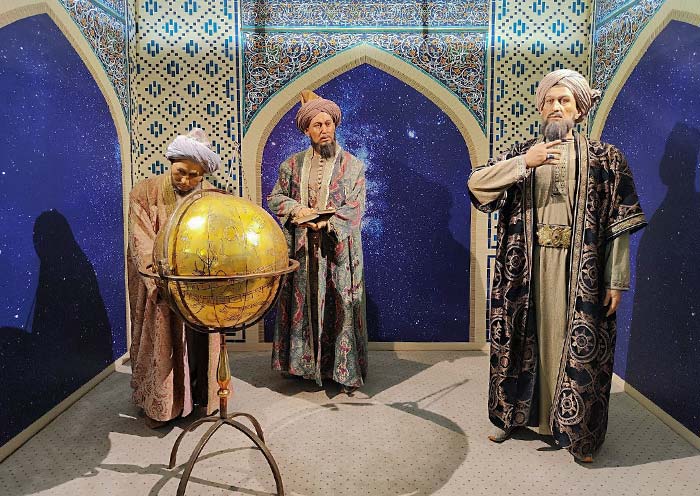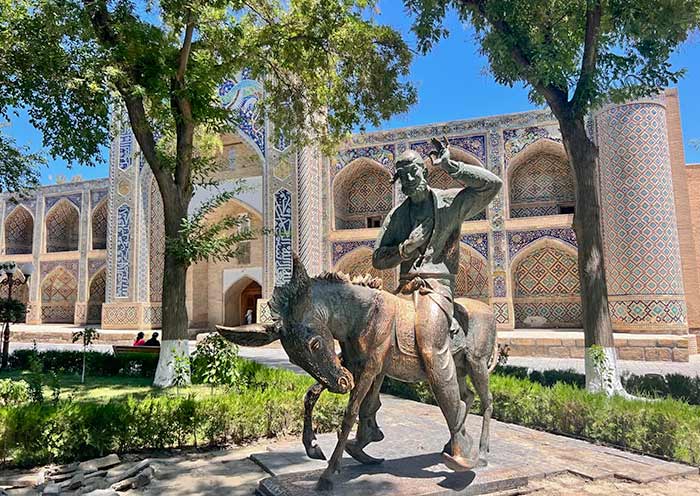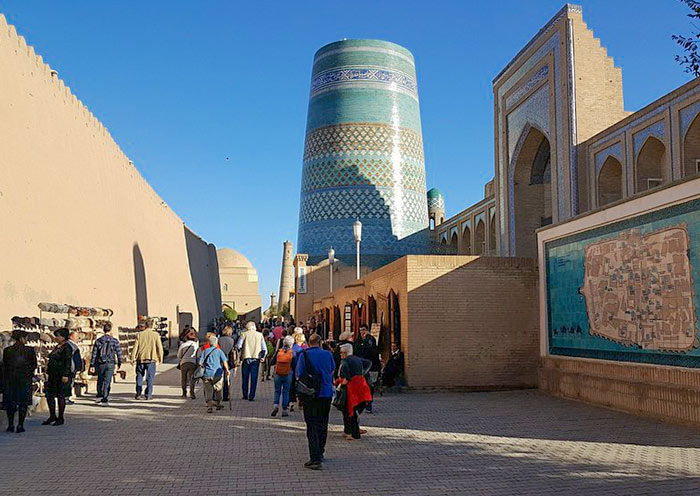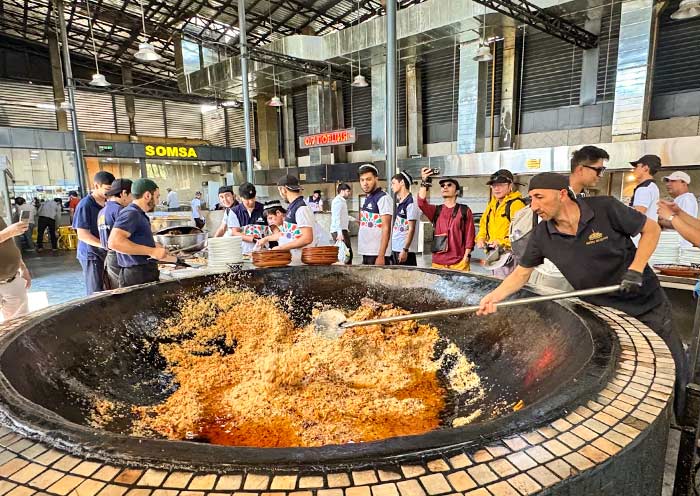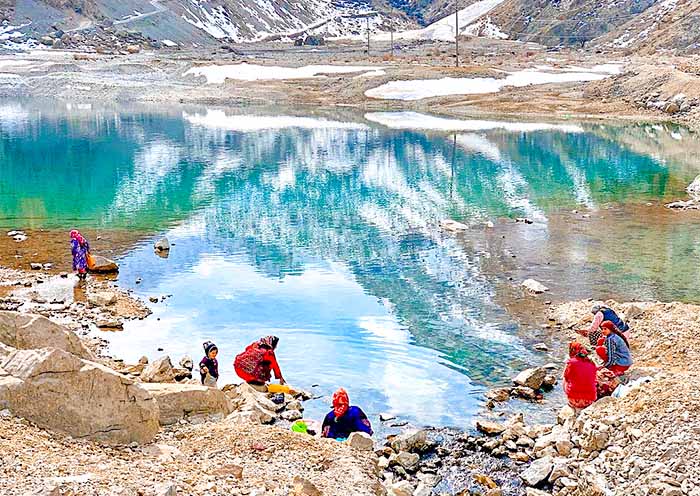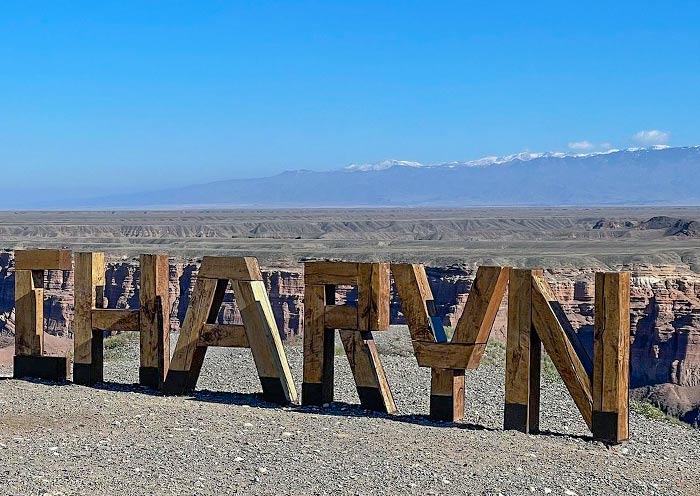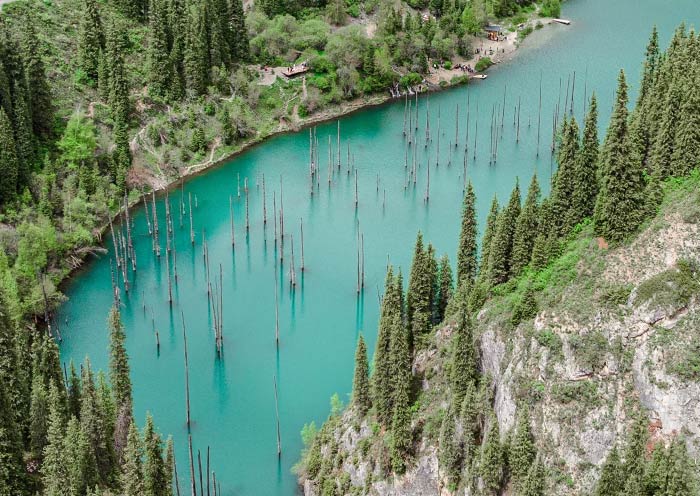8 Days Uzbekistan Tour Package from Samarkand - The Silk Road Gem
- Highlights
- Itinerary
- Price
- Trip Notes
- Accommodation
- Photos
- Reviews
Uzbekistan Odyssey: A Silk Road Adventure Across Four Cities in 8 Days
A Silk Road Dream Through Samarkand, Bukhara, Khiva, and Tashkent - where history, culture, and beauty collide. Book our 8 Days Uzbekistan Tour Package now! Step into a living fairy tale of turquoise domes, ancient bazaars, and legendary cities.
Wander Samarkand’s Registan Square, a tapestry of golden-tiled madrasahs, and trace Timur’s legacy at Gur-Emir Mausoleum. In Bukhara, lose yourself in Lyabi Hauz’s cobblestone charm, the Po-i-Kalyan’s towering minaret, and the ancient Ark Fortress. Step into Khiva’s walled Ichan-kala, a living museum of minarets, palaces, and blue-tiled mausoleums. End in Tashkent, where Soviet-era metro wonders, bustling Chorsu Bazaar, and Khast-Imam’s spiritual energy bridge past and present.
This 8 Days Uzbekistan Tour from Samarkand weaves UNESCO sites, local flavors, and seamless travel into an immersive Silk Road experience - unforgettable from start to finish. Travel seamlessly by high-speed train and flight between these Silk Road jewels, with expert guides sharing tales of Timur, traders, and empires.

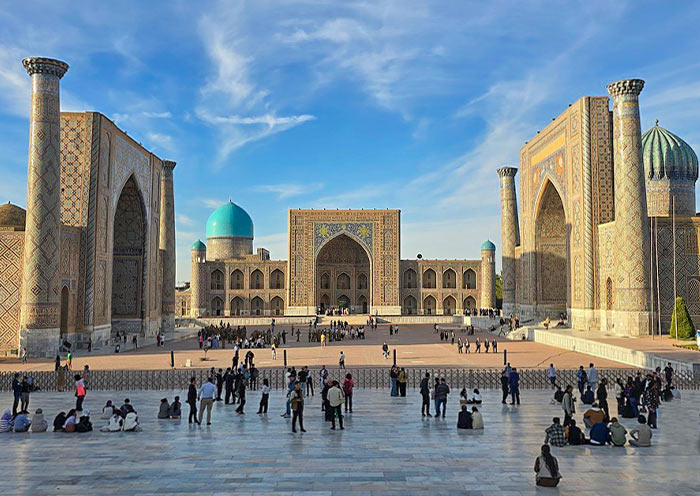


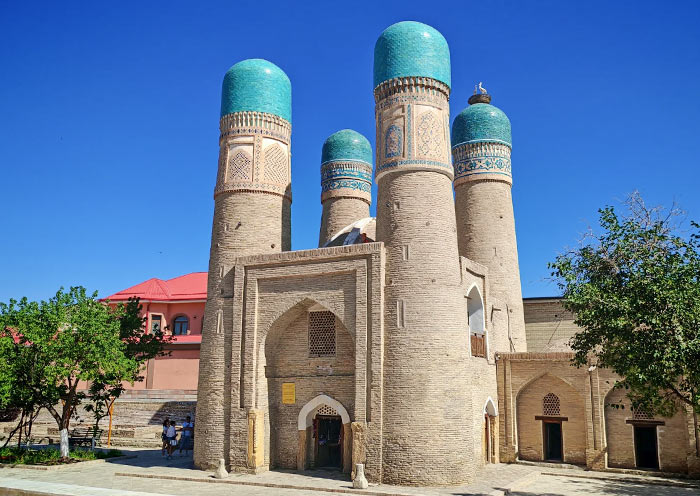
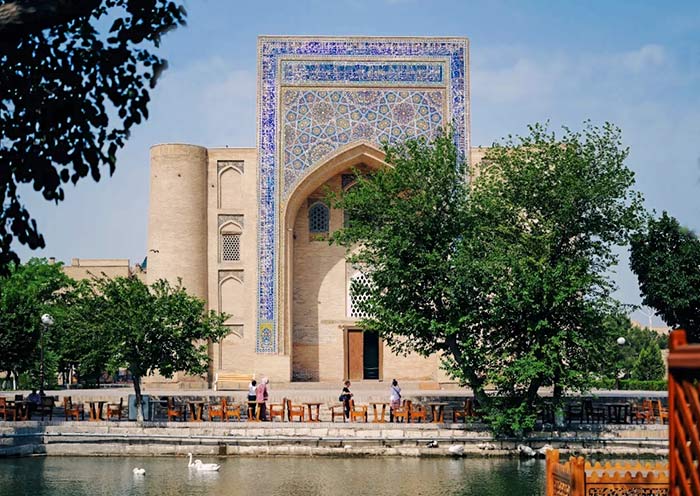
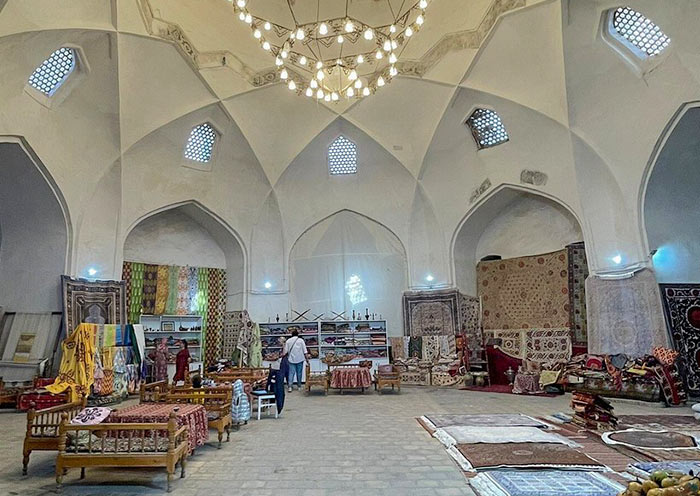

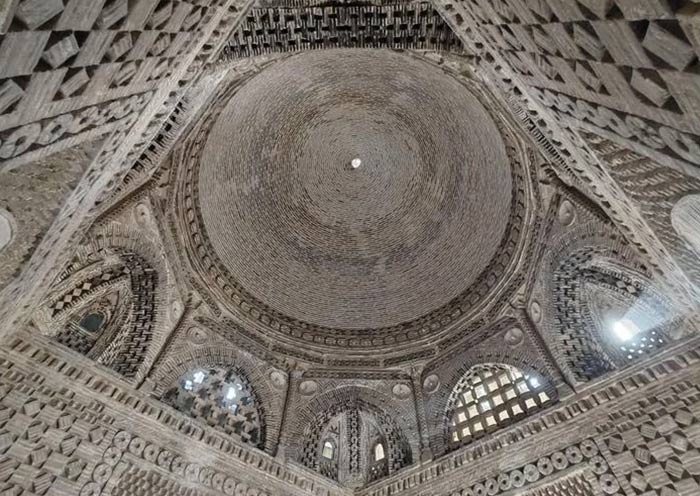
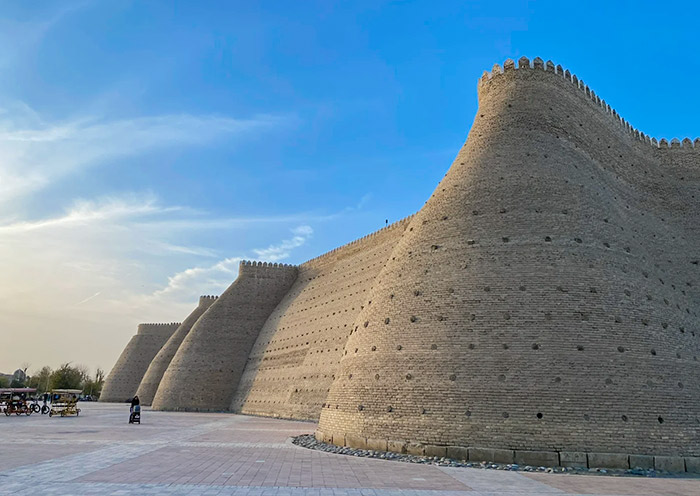
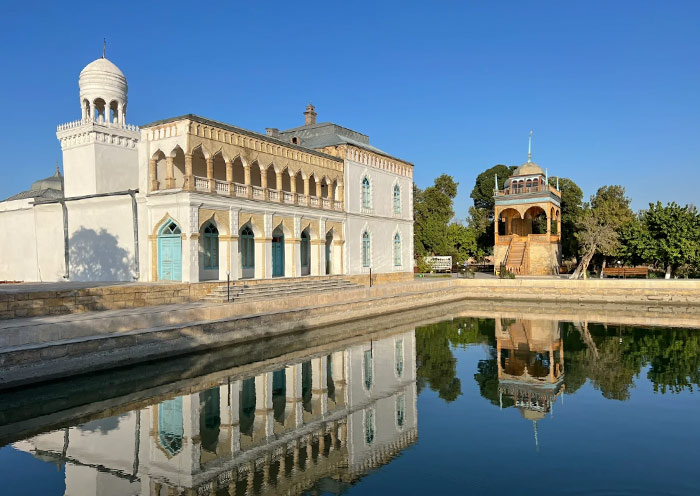
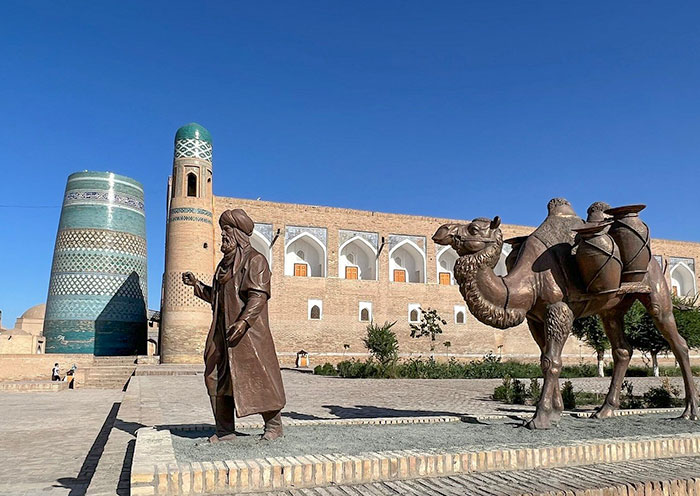


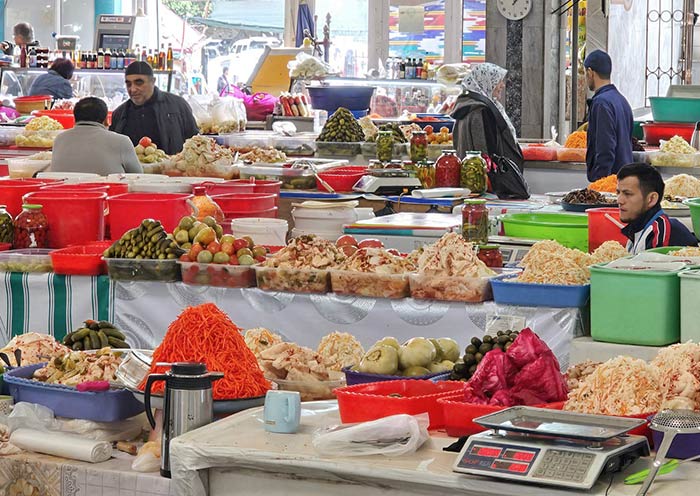
Itinerary at a Glance
Samarkand, Uzbekistan (2.5 Days)
Gur Emir Mausoleum (Timur’s Tomb), Registan Square, Bibi Khanim Mosque, Siyab Bazaar, Shahi Zinda Necropolis, Ulugh Beg Observatory, Khodja Doniyor Mausoleum (Tomb of Sait Daniel), Afrosiab Museum
Bukhara, Uzbekistan (2 Days)
Chor Minor Madrasah (Four Minarets), Lyabi Hauz Ensemble (Afandi Statue), Magoki Attori Mosque, Trading Domes, Po-i-Kalyan Complex (Kalyan Minaret), Ark of Bukhara (Ark Fortress), Bolo Hauz Mosque, Sitorai Mokhi Khosa Palace, Ismail Samani Mausoleum, Chashma-Ayub Mausoleum
Khiva, Uzbekistan (1.5 Days)
Ichan-kala (Kalta Minor Minaret, Pakhlavan Makhmud Mausoleum, Islam Khoja Minaret, Juma Mosque, Tosh Hovli Palace, Kuhna Ark)
Tashkent, Uzbekistan (2 Days)
Khast-Imam Complex (Hazrati Imam Complex), Chorsu Bazaar, State Museum of Applied Arts, Tashkent Metro (Soviet-era), Amir Timur Square
Itinerary Day by Day
Welcome to Samarkand, Uzbekistan – Heart of the Silk Road! Samarkand is a jewel of the Silk Road. It is more than just a destination - it’s an experience. It’s where history comes alive, art inspires wonder, and culture feels tangible. Whether you’re a history buff, a photography enthusiast, or simply someone looking to immerse yourself in a new culture, Samarkand will leave you enchanted.
Upon your arrival at Samarkand International Airport, your guide will greet you with a sign bearing your name at the arrivals gate. From there, it's about 7 km drive to the downtown area.
Ready to Walk through 2,700 years of history in one dazzling city. Delve into the legacy of Timur and his dynasty, and lose yourself in one of the oldest cities in the world that truly lives up to its legendary status.
Free Time Idea:
Registan Square of Samarkand (Evening View): golden-lit madrasahs, dazzling light shows, magical atmosphere - surreal history and beauty, ideal for photos.
Arrival Ideas:
1. For Flights: Direct flights to Samarkand International Airport connect you to this Silk Road gem from major cities like Istanbul, Moscow, and Dubai. Seasonal routes from European cities are expanding. Direct domestic flights also link Samarkand to other cities in Uzbekistan, including Tashkent.
2. For Visas: Over 60 nationalities enjoy visa-free entry, and a simple e-visa is available for others online. Confirm entry rules via Uzbekistan’s e-visa portal pre-travel. Ensure your passport has at least six months' validity for a smooth entry process.
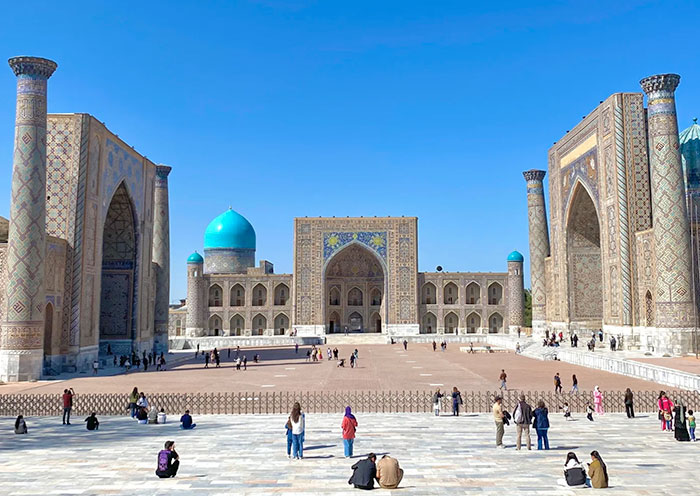

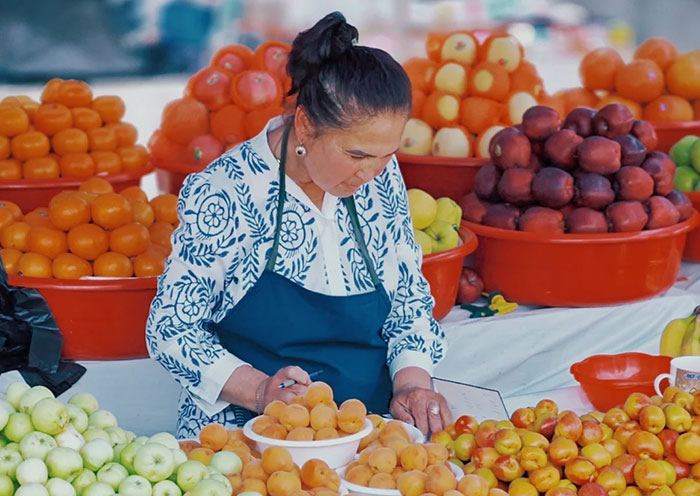
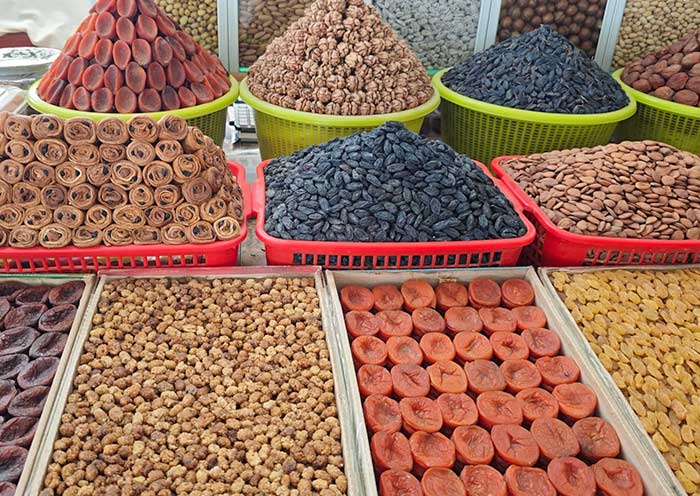
Enjoy your time in Samarkand (World Heritage Site), the capital of the Timurid Empire (14th–15th centuries) & Uzbekistan’s Second-largest City. From Gur Emir Mausoleum (tomb of Timur) to Registan Square (Central Asia’s most famous), Bibi Khanim Mosque (commemorate Timur's wife), Shahi Zinda Necropolis (an open-air art gallery), and Siyab Bazaar (for plov & bread), you will find that its atmosphere is centered around memorial architecture of breathtaking scale & beauty, reflecting the glory and power of the Timurid Dynasty.
Start with a visit to Gur-e Amir Mausoleumof the Mongol Conqueror Amir Timur. Completed in 1404, it was originally intended to be the tomb of Timur’s grandson, but after Timur died in 1405, he was interred there as well, along with other members of his family. The mausoleum dazzles with its majestic azure ribbed dome - a prototype for later Mughal architecture, including India’s Taj Mahal. Inside, marvel at the lavish gold-leaf interior, intricate jade tombstones, and ornate calligraphy adorning the walls.
You can look for the inscribed jade plaque marking Timur’s grave - a sacred site shrouded in legend and power. Legend has it that there was a warning against opening the grave, stating, “Whosoever disturbs my tomb will unleash an invader more terrible than I”. However, Soviet archeologists did so on June 19, 1941, and a few days later, Nazi Germany attacked the USSR. When they reburied the remains in 1942, the victorious battle of Stalingrad began. The Soviet anthropologists confirmed Timur’s height (172 cm) and lameness, and the fact that Timur's grandson, Ulugh Beg, was assassinated.
The complex comprised a madrasah & a khanaka (prince’s residence), both facing the rectangular courtyard, as well as four minarets at the courtyard corners and an entrance portal. Now, only the foundations of the madrasah and khanaka, the entrance portal, and a part of one of four minarets remain.
Next, visit Registan Square, a must for experiencing the grandeur of Samarkand & the heart of the Silk Road. The word “Registan” means “Sandy Place” in Tajik. Many centuries ago, the area of this square was all sand. In ancient times, the square served as a meeting place for the governing people and the residents to publicly announce the khans' decrees, to gather the army, to perform executions of bandits, or to celebrate folk festivals.
Located in the heart of Samarkand, this square is also known for the three medieval schools: Ulugh Beg Madrasa (built in 1420; celestial mosaics), Tilya-kori Madrasa (built in 1660; gold-leafed dome; cover photo of the Lonely Planet Book, The Silk Road), and Sher-Dor Madrasa (built in 1619; lion mosaics on Uzbekistan’s 200-som banknote).
Built by Ulugh Beg, Timur's grandson & a scientist on the throne, the Ulugh Beg Madrasa offered not only Islamic education but also astronomy, geometry, philosophy, and the natural sciences. The Sher-Dor Madrasa is famous for the “Lion” mosaic motif on the front of the building. Sher-Dor means “possessing lions”. The Lion mosaic is unique to medieval Islamic historic buildings, since depicting animals and people is against Sharia.
By day, admire intricate tilework and soak in the grandeur of Registan Square; by night, be captivated by magical light shows that bring the madrasahs to life. A blend of history, art, and spectacle, it’s a journey through the Silk Road’s golden age. (PS: You can see Registan Square on the 50 Uzbekistani som banknote.)
After that, move to explore Bibi Khanim Mosque (built in 1404), one of the most ambitious architectural projects of the Timurid period. Legend says the mosque was built by the Timur's favorite wife, Bibi-Khanym, in honor of his return from India. The architect fell madly in love with her and refused to finish the job unless he could give her a kiss. The smooch left a mark, and Timur, on seeing it, executed the architect and decreed that women should henceforth wear veils. The interiors of the mosque contain gilding, imitating local brocade embroideries.
Right next to Bibi Khanim Mosque, Siyab Bazaar is a sensory delight. This bustling market is a perfect place to experience local life, find fresh fruits, nuts, spices, and famous Samarkand bread.
At last, time to enjoy a walk in Shahi Zinda Necropolis, a captivating " avenue of mausoleums" and an open-air art gallery. It is an 11th-15th c. "Living King" necropolis along a hillside path. Admire Timurid-era blue-tile masterpieces, including tombs of Timur’s family (women) members and high-ranking officials. Legend of Prophet Muhammad’s cousin’s tomb adds mystique. In recent years, Shah-i-Zinda has become not only a pilgrimage site but also a favorite destination for photography due to its beauty.



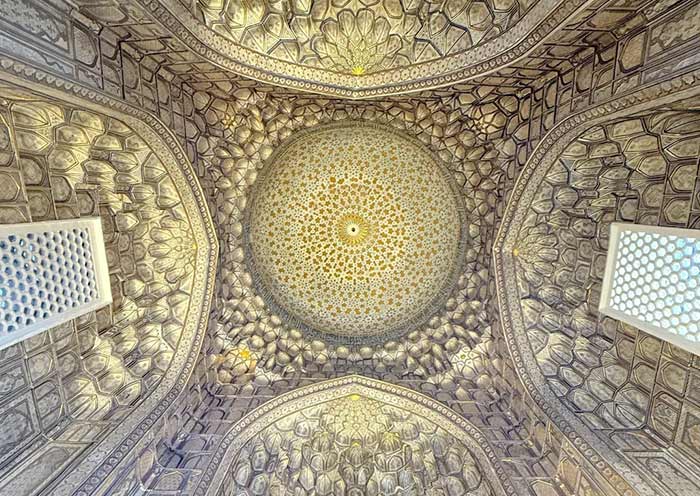
In the morning, explore more about Samarkand, the Silk Road gem. With a visit to the Ulugh Beg Observatory, Tomb of Sait Daniel, and Afrosiab Museum, you may see why it was the center of history, culture, and scientific contributions in the past. Then, take a train to Bukhara, the Religious and Academic Capital of the Silk Road.
The Ulugh Beg Observatory is a must-visit for history and astronomy enthusiasts. Built in the 1420s by the renowned Astronomer King Ulugh Beg (grandson of the emperor Timur), it was one of the most advanced observatories of its time. Destroyed in 1449 and rediscovered in 1908, the ruins reveal medieval Samarkand’s intellectual prowess. You should not miss the impressive sextant (11m long), used to calculate celestial positions with incredible accuracy. The on-site museum offers fascinating insights into Ulugh Beg’s contributions to science. Perched on a hill, the observatory combines breathtaking views of Samarkand with the legacy of a visionary astronomer.
Next, visit the Khodja Doniyor Mausoleum (Tomb of Sait Daniel), a sacred site revered by Muslims, Jews, and Christians alike. It houses the tomb of Prophet Daniel (under five domes), which stretches an astonishing 18 meters long due to a legend of the saint's remains growing over time. Timur brought Daniel’s relics here in the 15th century, creating a pilgrimage hub. This site, located on the banks of the Siab River, also features a sacred spring with healing properties, making it a peaceful and powerful place to reflect and witness the confluence of different faiths. It is a great spot to undestand Samarkand – the crossroads of cultures.
Before transferring to train station for Tashkent, it’s a great idea to conclude your Samarkand tour with a visit to the Afrosiab Museum. This museum, built atop Samarkand’s 2,500-year-old ruins, unveils the city’s ancient soul. Its crown jewel is the 7th-century Sogdian frescoes, notably the "Hall of Ambassadors" mural, depicting King Varkhuman receiving envoys from China, Persia, and beyond—a testament to Silk Road diplomacy. Artifacts like pottery, coins, and ossuaries trace eras from the Achaemenid to Timurid periods, while a scale model reconstructs the pre-Mongol metropolis. A must for history lovers to walk through a lost golden age.
Take a train ride to Bukhara for overnight.

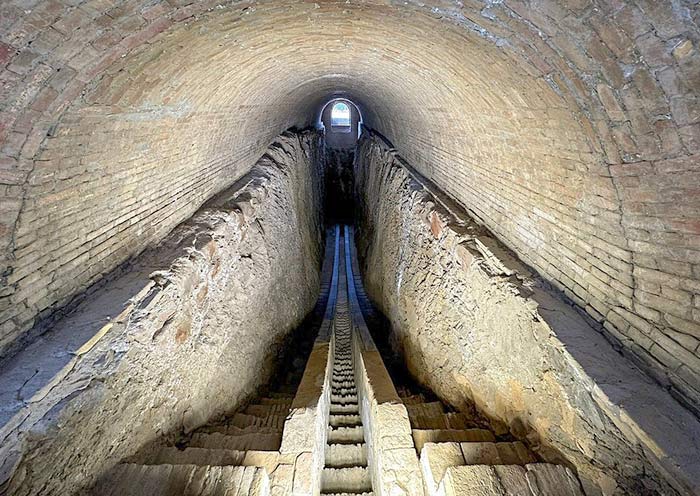
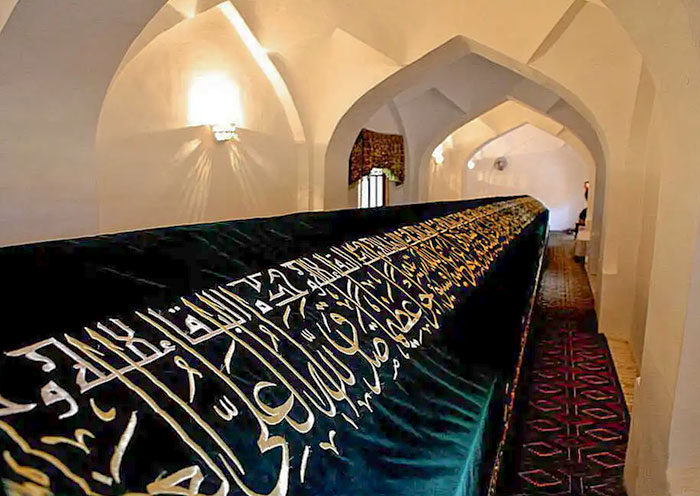

Take a morning train to explore Bukhara, a UNESCO site. Referred to as the "Second Mecca", Bukhara is famous as a 2,500-year-old Silk Road Hub (Samanids to Timurids) and a center for Islamic scholarship. It is also the legendary home of Afandi & is an ancient city tied with the One Thousand and One Nights.
Bukhara is a medium-sized city & nearly all monuments are within walking distance. From Chor Minor to Lyabi Khause Square, Magoki Attori Mosque, Trading Domes, Kalyan Minaret & Ark Fortress, it is about 6 km city walk. Ready to get lost in its living history, friendly locals, and vibrant bazaars!
When you arrive in Bukhara, you'll transfer to Chor Minor Madrasah, the Lonely Planet Central Asia cover star. "Chor Minor" means "four minarets" in Persian. The four minarets were built in 1807 by the wealthy Turkmen merchant Khalif Niyazkul for his four daughters. Each of the towers has a unique decoration. Some people believe that the four different designs reflect the world’s four religions. You may see clear images of Buddhist prayer wheels, Christian crosses, Zoroastrian motifs, or Islamic motifs. It is said that the surviving four-tower structure is part of the gateway from a once-existing madrasah complex.
Next, head to the Lyabi Hauz Ensemble (Lyabi Khause Square), Bukhara’s vibrant 17th-century heart. It was a trade square built around a pool dug in 1620 and shaded by ancient mulberry trees. “Lyabi-Hauz” in Persian means "by the pool." The ensemble’s large artificial pool (42 m long, 36 m wide, and 5 m deep) is surrounded on three sides by three majestic buildings: the Nadir Divan-Beghi Madrasah (built in 1622; famous for two birds carrying deer toward a "man-in-the-sun" mosaic motif; inspired by Sher-Dor Madrasa’s “Lion” mosaic motif in Samarkand Registan), the Nadir Divan-Beghi Khanaka (a Sufi hospice & monastery, also built in 1622), and the Kukeldash Madrasah (built in 1568). In ancient Bukhara, there were more than 80 such pools, which supplied the city with water. However, they were notorious for spreading disease and were mostly filled in during the 1920s and 1930s.
Built by Nadir Divan-begi (Grand Vizier/prime minister), Lyabi Hauz was once a bustling Silk Road trade hub. It is now alive with cafes and local life. People gather to enjoy tea, watch local craftsmen, and bask in the ambiance of Bukhara’s Silk Road legacy. Don't miss the charming statue of Khodja Nasreddin (Afandi), the wise fool of Sufi legend, riding his mischievous mule. Afandi is a beloved character in the folklore of the entire Muslim world.
You should not miss the Magoki Attori Mosque, Bukhara’s oldest surviving mosque (9th-10th c.). Magok means "recessed," a fitting name since the mosque is located 4.5 meters underground. Marvel at its ancient brickwork, intricate terracotta tiles, and its remarkable survival as a pre-Mongol relic. Today, it houses a carpet museum (self-pay for museum ticket).
After that, continue exploring Trading Domes, the iconic image of Bukhara. They are located on a central pedestrian route in the heart of Bukhara, from the Lyabi Hauz to the Po-i-Kalyan Complex. In the Middle Ages, Bukhara was a major hub on the Silk Road, leading to the proliferation of marketplaces and shops. Today, four main trading domes remain: a cluster of 16th-century domed bazaars (Toki-Zargaron, Toki-Sarrofon, Telpak-Furushon & Tim Abdullah Khan) that once thrived as hubs for jewelry, currency exchange, hats & carpets. Nowadays, you can see stalls selling traditional crafts, textiles, and souvenirs. Enjoy a glimpse into Bukhara’s mercantile past.
Then, you will reach Po-i-Kalyan Complex, the visual high point of the city’s skyline. At Poi Kalon Square, you will see three majestic structures built between the 12th and 16th centuries: the Kalyan Minaret, Kalyan Mosque & Mir-i Arab Madrasah. This breathtaking arrangement of minaret, mosque, and madrasa forms the spiritual and architectural heart of the old city, a perfect example of harmonious design.
The iconic Kalyan Minaret, which once guided Silk Road caravans, was built in 1127. Standing 47 meters tall, it earned the title "Tower of Death" due to ancient legends. During the siege of Bukhara in 1220, Genghis Khan was so mesmerized by this minaret that he spared it from destruction.
The Kalon Mosque (Great Mosque) is a vast hypostyle with 288 domes, capable of holding 10,000 worshippers. The Mir-i-Arab Madrasa is a top Islamic school with stunning turquoise domes and intricate tilework. Constructed with the profits from the sale of 3,000 Persian slaves, the madrasa combines Timurid architecture with active scholarship. Together, these buildings embody Silk Road grandeur—making the complex ideal for photos, history, and cultural immersion.
After that, head to explore the Ark of Bukhara (Ark Fortress), whose image was printed on Uzbekistan’s 2,000-som banknote. It is Bukhara’s ancient fortress, built the 5th c. AD, and rebuilt in the 16th–17th c. For centuries, it served as a royal town-within-a-town for Bukhara’s emirs. Its 11-meter-thick walls enclose museums, the 17th-century Coronation Mosque, a throne room, and prison cells. Outside, in front of the fortress, is medieval Bukhara’s main square, the Registan Square, a favourite venue for executions, including those of the British officers Stoddart and Conolly. Once a symbol of power, it now displays royal artifacts, weapons, and manuscripts. You can explore its labyrinthine chambers, climb the battlements for panoramic views of Bukhara, and learn about Bukhara’s medieval governance.
Located directly opposite the Ark of Bukhara, the Bolo Hauz Mosque (Mosque of the Forty Columns) is a stunning architectural gem. It is a royal mosque built in 1712, famed for its 20 intricately carved wooden pillars and their reflection in the adjacent "Forty Pillars" pond. Famous for its beautifully carved, brightly painted wooden columns and ornate ceiling, it once served as the emir’s Friday mosque. It is a peaceful spot to admire classic Uzbek artistry.
Free Time Idea:
Enjoy a sunset at the Ark of Bukhara. Climb to the top of its facade for a commanding panoramic view of Po-i-Kalyan Complex & the city.
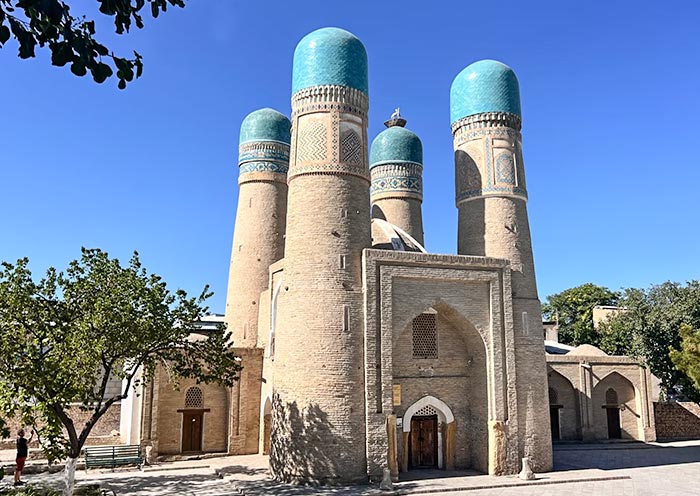
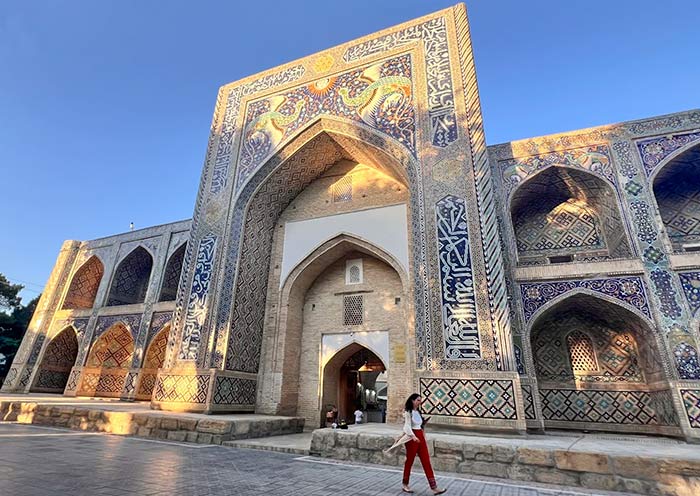
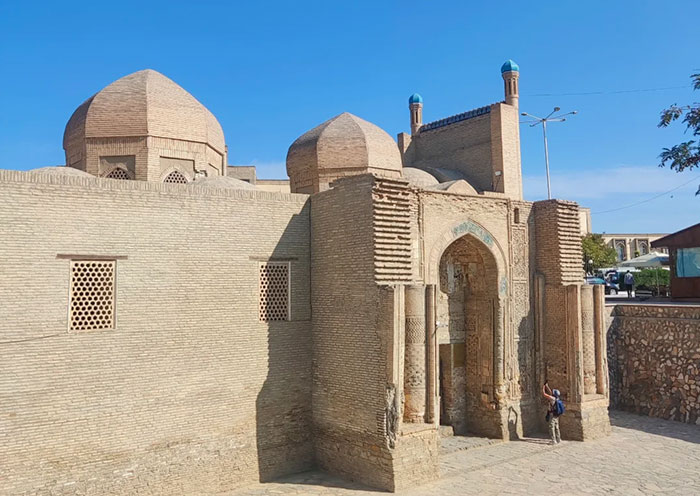
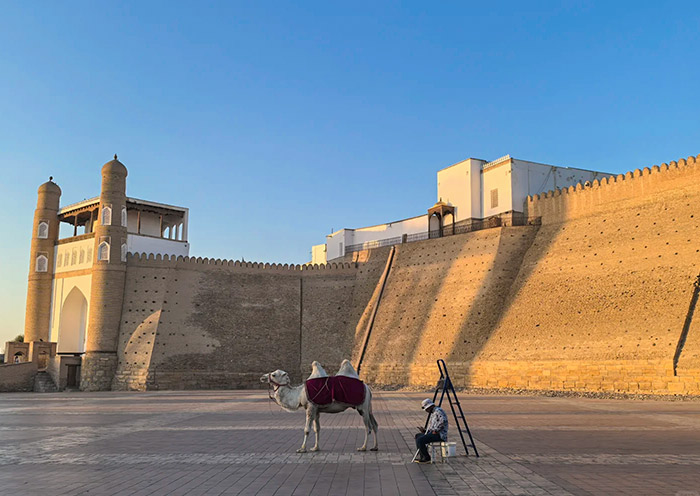
Today, you can enjoy your time in Bukhara before departing Khiva. Explore Bukhara's ancient palace & mausoleums. Then, take a train ride from Bukhara to Khiva.
First, head to the Sitorai Mokhi Khosa Palace, located in the outskirts of the city (4 km away). Escape to the summer palace of Bukhara's last emirs. Sitorai Mokhi Khosa means "Palace Like the Stars and the Moon". It was founded in 1822 by the Emir Nasrullah (Bukhara’s third-to last Emir) for his wife Sitora, after whom the palace is named. The current palace was built from 1912 to 1918 by order of the last Emir of Bukhara. In 1927, shortly after the fall of the Emirate, the palace was transformed into a museum.
Inside, you can see old palace furniture, Chinese and Japanese porcelain, various utensils, and a collection of the national dress of the 19th с decorated with the famous Bukhara gold embroidery.
The main attraction of the palace, however, is its interiors, where the fusion of Russian and Bukhara style reaches its peak. You can wander through its opulent rooms and admire the intricate craftsmanship, including the famous "White Hall" with its ganch carving on a mirrored background. The palace complex also features beautiful 7-hectare gardens where peacocks roam freely, just as they did a hundred years ago. A visit here provides a fascinating glimpse into the luxurious life of the emirate's royalty on the cusp of the 20th century.
Then, pay a visit to the Ismail Samani Mausoleum, the oldest funerary building in Central Asian architecture. It's the 9th-10th-century resting place of the Samanid ruler Ismail Samani and is the only surviving monument from the Samanid era. Regarded as an iconic example of early Islamic architecture, you can admire its intricate brickwork, geometric patterns, and durable construction. You will notice the mausoleum draws elements from early Sogdian architecture (heavy corner buttresses) and Sassanid fire worship (circular brick suns & the canopy shape of sacred Zoroastrian temples). A quiet refuge in Samani Park, it reflects early Islamic artistry without excessive ornamentation.
Next, move to Chashma-Ayub Mausoleum to see the Spring of Holy Ayub. The mausoleum dates back to the 12th century (built by Karakhanid rulers) and features a tent-like Karakhanid-style roof. It consists of the mausoleum and a holy spring. Legend has it that the prophet Job struck his staff on the ground here, causing a spring to appear whose water then cured him of his many boils and ulcers. Today, it includes a Museum of Water about water management in Bukhara & a tap where pilgrims drink from the spring.
On the train to Khiva, you can enjoy the view of the vast, sun-scorched Kyzylkum Desert (Red Sand Desert), where rolling red-sand dunes and sparse saxaul vegetation stretch to the horizon. As one of the largest and most fascinating deserts in Central Asia, the Kysylkum Desert covers an area of around 300,000 square kilometers across parts of Uzbekistan, Kazakhstan, and Turkmenistan.
Arrive in Khiva for an overnight stay.
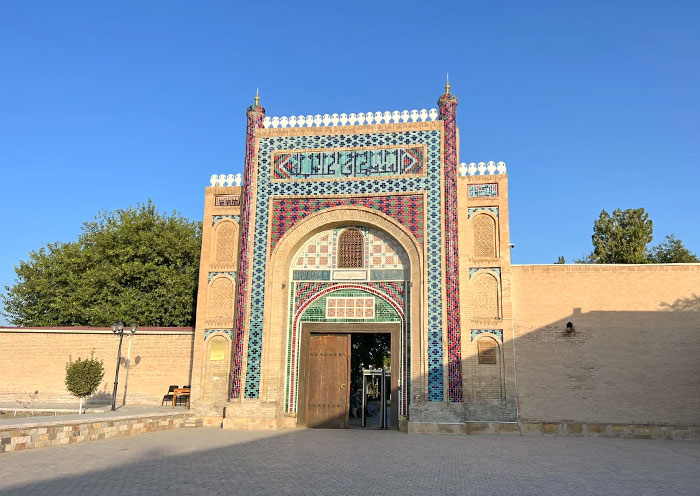


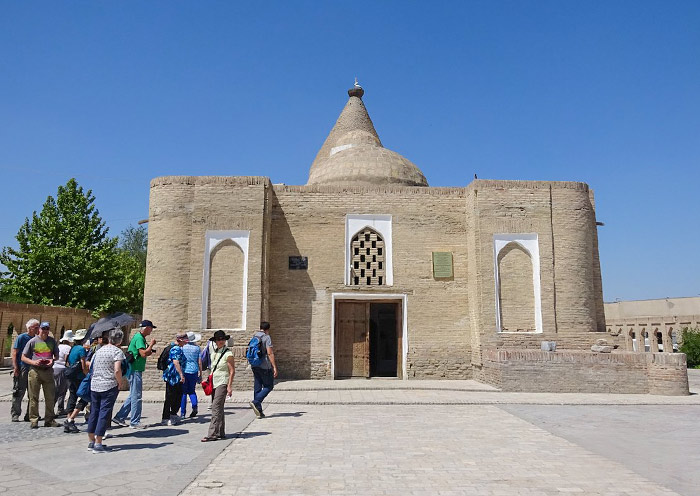
Start your day explore Khiva (World Heritage). Traveling in remote Khiva, feels like stepping through a portal in time. It thrived in the 16th century as a safe hub for Silk Road trade and cultural exchange, blending Persian, Turkic, and Russian influences.
I would offer a bag of gold merely to catch a glimpse of Khiva" is a well-known Central Asian saying that reflects the city's legendary beauty. Step into Khiva, a living "open-air museum" that functions as a perfect time machine to the medieval era. This reputation is built upon the magnificent Itchan Kala, the inner-walled city that remains a frozen-in-time gem.
As the heart of the Khwarezm Empire (10th-17th centuries), Itchan Kala boasts Central Asia’s only fully intact walled medieval fortress city, famed for its "fully preserved medieval walls" that rise 10 meters high to enclose the entire old town. Compact and charming, the historic core spans just 26 hectares, housing a permanent population of ~2,000 residents. All key sites (palaces, madrasahs, mosques, minarets, mausoleums) cluster within a 1-kilometer radius, making the labyrinth of mud-brick buildings, narrow alleys, and traditional tea houses easily explorable on foot.
You can enter from Ichan Kala West Gate (Ata Darvaza) to visit the landmark of Khiva - Kalta Minor Minaret (Short Minaret). The unfinished minaret (29 m; stopped at 1855) dazzles with colorful bands. Nearby, the Muhammad Amin Khan Madrasah (largest in Khiva & Central Asia), famed for azure tiles. Sayid Allauddin Mausoleum (Eastern saint and Sufi sheikh; 14th-century) offers quiet reflection. Pakhlavan Makhmud Mausoleum (Khiva’s patron saint/wrestler-poet), Khiva’s holiest site, boasts turquoise domes. Climb the Islam Khoja Minaret (57 m tall; self-pay) for panoramic views. The Juma Mosque (Friday Mosque) impresses with its “forest” of 218 ancient wooden columns. Allakuli Khan Madrasah features intricate tilework. Tosh Hovli Palace (Stone Palace) showcases harem quarters and mirrored halls. Mohammed Rakhim Khan Madrasa blends history and architecture. End at Kuhna Ark (Old Fortress), the 17th-century fortress with sweeping views of Khiva. You can visit khans’ harem, mint, stables, arsenal, barracks, mosque and jail to get a peek at the life of the khans.
You can also walk along the Itchan Kala Walls (self-pay), which provides incredible panoramic views of the entire old city & is a good spot for sunset viewing. (PS: You can see Itchan Kala on the 100,000 Uzbekistani som banknote.)
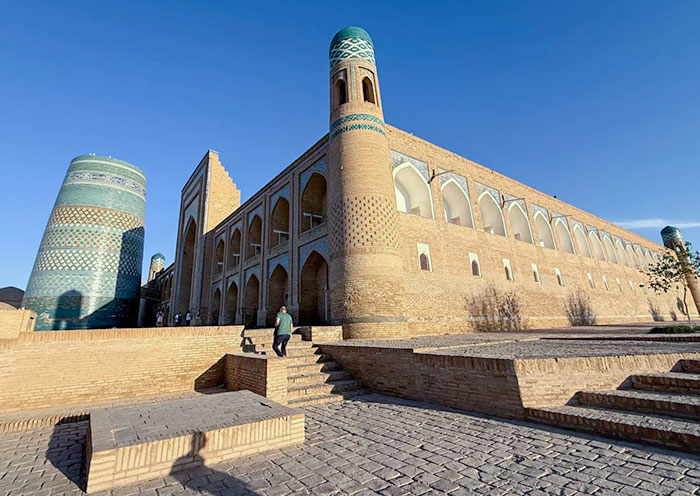

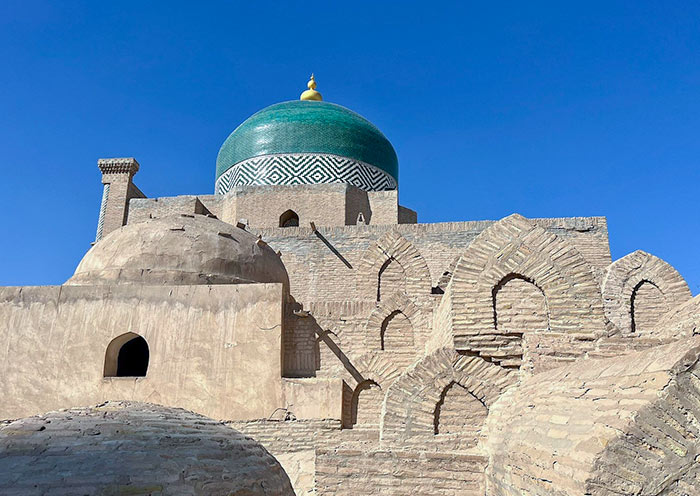
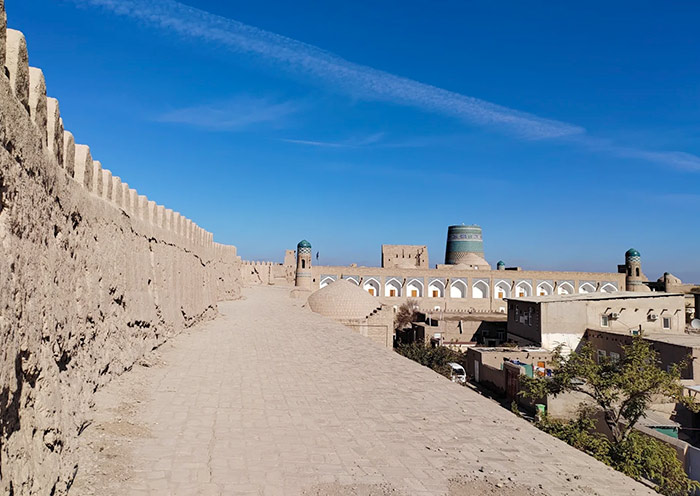
Welcome to Tashkent, Uzbekistan’s vibrant capital and largest city! It's the perfect gateway to the country's Silk Road wonders, blending Soviet grandeur with modern charm. Your journey awaits: explore the Soviet-era metro, bustling bazaars, and iconic mosques, and be sure to savor Plov, the National Dish.
Upon your arrival at Tashkent International Airport, your guide will greet you with a sign bearing your name at the arrivals gate. From there, it's about a one-hour drive to the downtown area to begin exploring Old and New Tashkent.
You will visit the Khast-Imam Complex, the spiritual heart of Tashkent’s Old City. This 15th-century Islamic ensemble blends ancient mausoleums, madrasas, and mosques. You can explore Hazrati Imam Mosque (built in 2007 by Uzbekistan’s first president), Tillya Sheikh Mosque, Barak Khan Madrasah, Mausoleum of Saint Abu Bakr Kaffal Shashi, Imam Al Bukhari Islamic Institute (where future preachers are taught), and Mui Muborak Library (home to the 15th-century Osman Qur’an, one of Islam’s oldest copies).
The Hazrat Imam Mosque has a pair of 53 m high minarets and two domes set in front of the square. The domes are covered with gold leaf from the inside, and the round hall at the entrance is decorated with sandalwood columns.
You can also explore Barak-Khan Madrasah. The teal-domed parts of the complex were originally a “Nameless” Mausoleum, later converted into a madrassah, under the rule of Barak Khan, who ruled the Golden Horde from 1423 to 1429. Today, the madrassah is filled with workshops and small stores producing and selling ikat fabrics, jewelry, woodcarvings, and pottery.
You can visit Mausoleum of Saint Abu Bakr Kaffal Shashi, the final resting place of Hazrati Imam or Abubakr Muhammad Kaffal Shashi (the first Imam of Tashkent City). This 10th-century imam was also a scientist, poet, craftsman, and scholar of the Koran. According to legend, he received the nickname of Kaffal (“locksmith”) after the wonderful locks he built, each of which had a key weighing three pounds.
Located in the Old City, Hazrati Imam Complex (Khast-Imam Complex) is an oasis of intricate blue domes, towering minarets, quiet gardens, and vibrant tile work, offering a serene and beautiful cultural experience.
Next, journey into the soul of Old Tashkent at Chorsu Bazaar, the city’s largest market. This iconic blue-domed market overflows with vibrant spices, traditional crafts, fresh bread, and dried fruits. Experience vibrant culture, delicious street food, and a unique atmosphere in this lively hub.
To learn about the history of Uzbek craft art and see its masterpieces, simply visit the State Museum of Applied Arts. Established in 1927, the museum's collection contains more than 7,000 of the best works by masters from the early 19th century to the present day. These include ceramics, jewelry, gold embroidery, national clothing, suzans, carpets, skullcaps, miniatures and paintings on wood, porcelain, musical instruments...
After that, it is time to experience the Tashkent Metro. More than a transit system, it is a magnificent underground art gallery. As Central Asia's first subway, it has been blending Soviet grandeur with Uzbek artistry since 1977. From mosaic-clad stations like Kosmonavtlar (cosmonaut murals) to Paxtakor (cotton motifs), you can admire stunning Soviet-era architecture, chandeliers, and intricate mosaics on a unique and beautiful journey through the city.
You can exit Amir Temur Metro Station to explore Modern Tashkent, beginning at Amir Timur Square, a central city landmark. The square is surrounded by notable buildings, Hotel Uzbekistan, Amir Timur Museum, Independence Square, University of Law, the well-known Tashkent Chime, and the Palace of International Forum, one of the most grandiose architectural structures in Tashkent.
The centerpiece of Amir Temur Square is the bronze statue of Amir Temur on horseback, the founder of the Timurid Empire. You can also explore the surrounding green spaces and fountains, and visit the nearby museum to delve deeper into the history of one of Uzbekistan’s greatest figures.
Optional: (If time permits)
Amir Timur Museum (Closed on Mondays; Self-pay; 10:00-18:00): The exterior of the museum is featured on the 1,000 Uzbekistani som banknote.
Free Time Ideas:
1.Independence Square: Tashkent’s largest plaza symbolizing freedom. Stroll through its lush gardens, admire stunning fountains, visit Independence Monument & Eternal Flame, which honor Uzbekistan’s history, culture & sovereignty.
2.Alisher Navoiy Theater (Self-pay): Experience Tashkent's cultural heartbeat. Watch world-class concerts, operas, or ballets in ornate halls, which are lavishly adorned with mosaic domes and gold leaf. Tickets are also very affordable.
3.Magic City Park (Little Disneyland; 10:00-22:00): Enchanting fairy-tale architecture, dazzling light shows, and musical fountains. Perfect for photos, shopping, and dining. No need to pay an entrance fee, but you will pay for each activity separately.

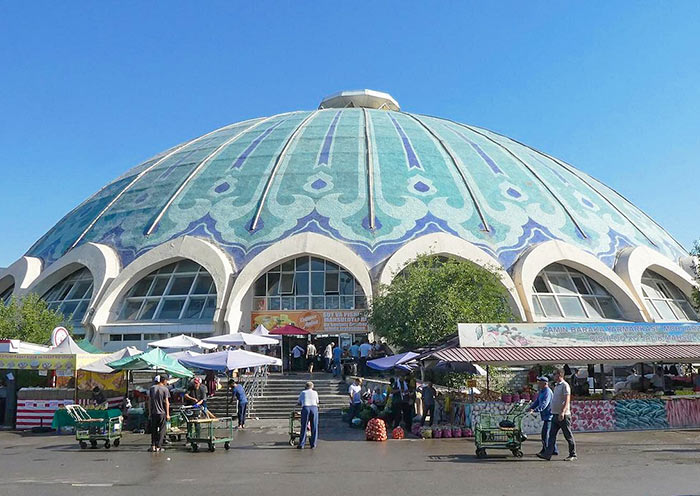
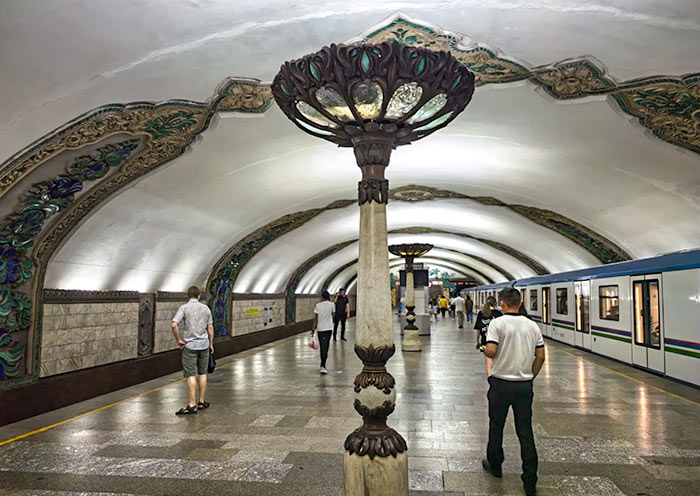

It is time to end your unforgettable 8 Days Uzbekistan Tour. Your driver will ensure a smooth transfer to Tashkent International Airport for your departure flight.
Trip Extension: If you'd like to extend your adventures in Central Asia, consider exploring other notable regions like Kyrgyzstan, Kazakhstan, Tajikistan, and Turkmenistan, etc. Feel free to contact us to customize your extended itinerary.
Thank you for choosing Asia Odyssey Travel for your tour of Asia. We are dedicated to enhancing your travel experiences and look forward to welcoming you on your next adventure in Asia. Have a safe journey home!
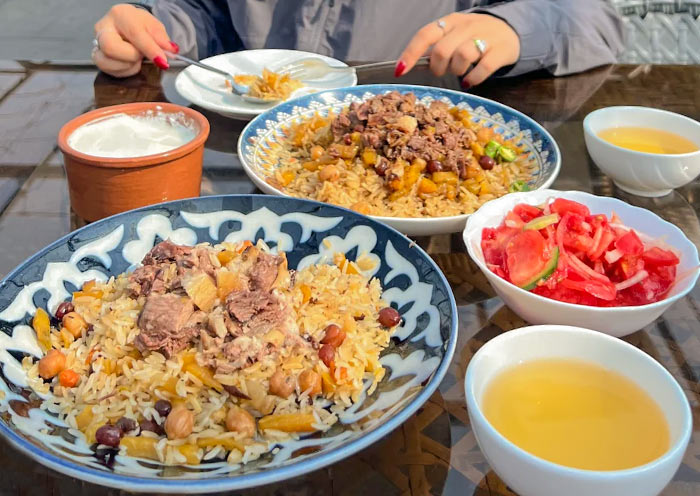

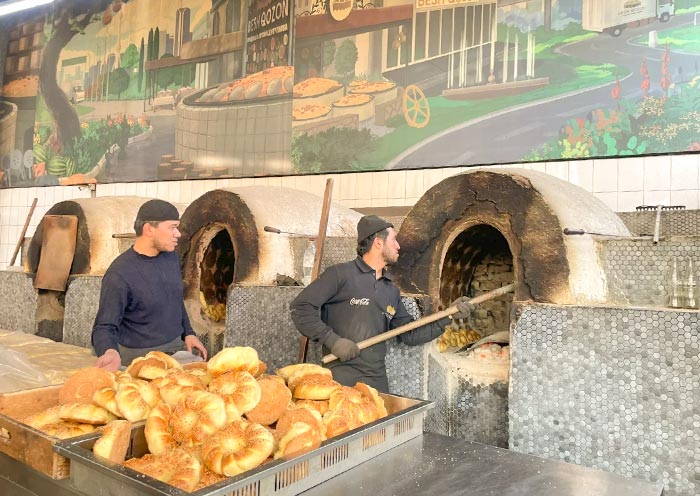
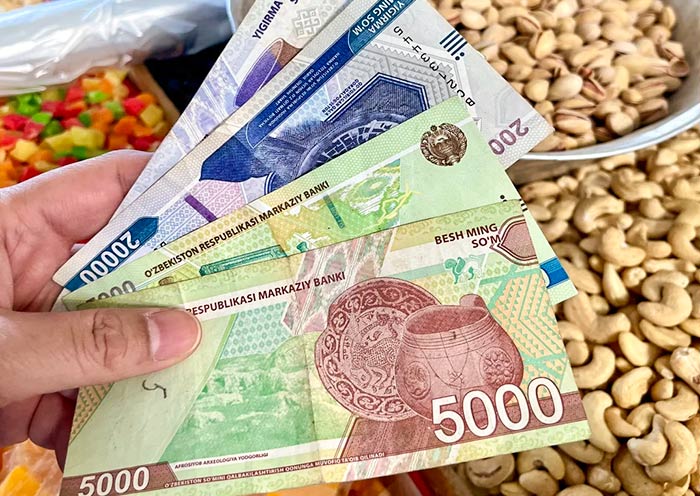
Price: What’s Included & What’s Excluded
What's Included:
What's Excluded:
Central Asia Trip Notes & Booking Tips
| Country | Highlights | Must-Do Experiences |
|---|---|---|
| Kazakhstan | Endless steppe, futuristic cities, striking natural wonders | Explore Almaty’s lively streets, marvel at Charyn Canyon, ride cable cars to mountain viewpoints, and learn about nomadic horse culture |
| Kyrgyzstan | Mountain peaks, alpine lakes, nomadic spirit | Stay in a yurt at Issyk-Kul Lake, visit Burana Tower, hike alpine gorges, and watch eagle hunting demonstrations |
| Uzbekistan | Silk Road jewels, turquoise domes, vibrant bazaars | Wander Registan Square in Samarkand, explore Bukhara’s old town, admire mosaics in Shakhrisabz, shop for silk, spices, and carpets |
| Tajikistan | Rugged mountains, hidden valleys, Sogdian history | Discover Penjikent’s ruins, trek to the Seven Lakes, and meet locals in remote mountain villages |
| Turkmenistan | Marble cities, desert mysteries, Silk Road ruins | Camp by the fiery Darvaza Gas Crater, explore Ancient Merv, and see Ashgabat’s white-marble monuments |
- Spring (April June): Mild weather, blooming valleys, fewer crowds
(1) Perfect for sightseeing in Uzbekistan’s Silk Road cities (Samarkand, Bukhara, Khiva) before the summer heat. (2) Kyrgyzstan’s and Kazakhstan’s mountains are lush and green, great for gentle hikes. (3) Desert areas in Turkmenistan are comfortable for visiting Darvaza Gas Crater and Merv.
- Autumn (September October) - Most Recommended Season: Pleasant temperatures, colorful landscapes
(1) Ideal time for a grand tour of all 5 Stans. (2) Crisp, sunny days make exploring cities and mountain regions easy. (3) Harvest season - fresh fruits, bazaars full of melons, grapes, pomegranates. (4) Issyk-Kul Lake and alpine gorges in Kyrgyzstan are at their most photogenic.
- Summer (July August): Hot in deserts & Silk Road cities (up to 40°C), but: great for high-altitude trekking in Kyrgyzstan and Tajikistan (Pamir Mountains, Seven Lakes).
For most western / developed-country travelers, Kazakhstan, Kyrgyzstan, Uzbekistan, and Tajikistan are fairly easy to enter (visa-free or e-visa) if you plan properly.
Turkmenistan remains the most challenging: must plan ahead, may need a LOI, possibly limit to tour operator itineraries.
Always check entry point regulations (airport vs land border), as some visas / e-visas / visa-on-arrival are only valid through certain border crossings.
Double-check the duration you're allowed (30, 45, 60, 90 days) - depends heavily on your passport country.
| Theme | Highlights | Where |
|---|---|---|
| Silk Road Cultures | Wander historic Silk Road cities with turquoise domes and caravanserais | Uzbekistan: Samarkand, Bukhara, Khiva |
| Explore an ancient Sogdian city and its 7thcentury frescoes | Tajikistan: Penjikent | |
| Contrast Ashgabat’s modern whitemarble skyline with the ruins of ancient Merv | Turkmenistan: Ashgabat, Merv | |
| Meet artisans weaving carpets, baking traditional bread, crafting felt yurts - living nomadic traditions | Across Central Asia (community workshops, markets, yurt makers) | |
| Nature Landscapes | Marvel at the Darvaza Gas Crater glowing in the Karakum Desert | Turkmenistan: Darvaza, Karakum Desert |
| Relax by IssykKul, the “Pearl of Kyrgyzstan,” ringed by snowcapped peaks | Kyrgyzstan: IssykKul Lake | |
| Hike to Tajikistan’s Seven Lakes or explore the “little brother” to the Grand Canyon | Tajikistan: Seven Lakes; Kazakhstan: Charyn Canyon | |
| Experience nomadic life in a yurt camp, ride horses in alpine valleys, stargaze on the steppe | Kyrgyzstan, Kazakhstan (yurt camps, alpine pastures) |
- Darvaza Gas Crater camping with desert stargazing
- In-depth Silk Road exploration of Samarkand’s old city
- Tajikistan’s Seven Lakes hike with a lakeside picnic
- Kyrgyz falconry show and hands-on yurt-making experience
- Charyn Canyon hike plus Almaty cable car to a skyline night view
- Tajik home visit with demonstrations of traditional handicrafts
Our tour is designed to provide a comprehensive experience without feeling overly rushed. We balance city tours with travel days to ensure you get enough rest. While some days involve long drives between destinations, we plan strategic stops for sightseeing and breaks. You'll have time to explore the major sites in each city and enjoy the journey between them. The pace varies by region: cities like Samarkand are fast-paced, while the mountain regions of Tajikistan and Kyrgyzstan offer a slower, more relaxed tempo.
Here’s what to expect at the most commonly used checkpoints:
| Border Crossing | Connects | Opening Hours | Crossing Time | Crossing Type | Notes for Travelers |
|---|---|---|---|---|---|
| Oybek | Tashkent (Uzbekistan) ⇆ Khujand (Tajikistan) | Daily, usually 08:00–18:00 | ~30–60 min (may be longer on weekends/holidays) | Pedestrian & vehicle | One of the busiest crossings; be ready for lines. Good road conditions on both sides. |
| Jartepa | Samarkand (Uzbekistan) ⇆ Penjikent (Tajikistan) | Daily, 08:00–18:00 | ~20–40 min | Pedestrian & vehicle | Most convenient for travelers; short transfer, border staff generally friendly. |
| Shavat | Khiva/Urgench (Uzbekistan) ⇆ Dashoguz (Turkmenistan) | Daily, 09:00–18:00 | ~45–90 min | Pedestrian only (vehicles drop/pick up travelers at both sides) | Requires Turkmen visa in advance or pre-arranged LOI. Can be busy in mornings. |
| Farap | Bukhara (Uzbekistan) ⇆ Turkmenabat (Turkmenistan/Mary route) | Daily, 08:00–18:00 | ~1–2 hrs | Pedestrian & vehicle | Key crossing for travelers heading to Merv; customs can take longer, be patient. |
| Korday | Bishkek (Kyrgyzstan) ⇆ Almaty (Kazakhstan) | Open 24 hrs | ~30–60 min (rush hours longer) | Pedestrian & vehicle | Major highway crossing, usually efficient; popular with locals and travelers. |
Traveler Tips:
- Timing Matters: Arrive early in the morning to avoid queues, especially at Shavat & Farap.
- Paperwork Ready: Keep passports, visas (or e-visa printouts), and customs forms handy.
- Walking vs. Vehicle:At some borders (Shavat, Oybek), you may need to walk across the neutral zone (few hundred meters).
- Seasonal Considerations: Summer is busier due to local travel; winter may bring delays from weather.
- Patience & Flexibility: Border procedures are generally friendly but not always fast - use this time to experience the real pace of Central Asia.
Hotels & Camping Experiences in Central Asia
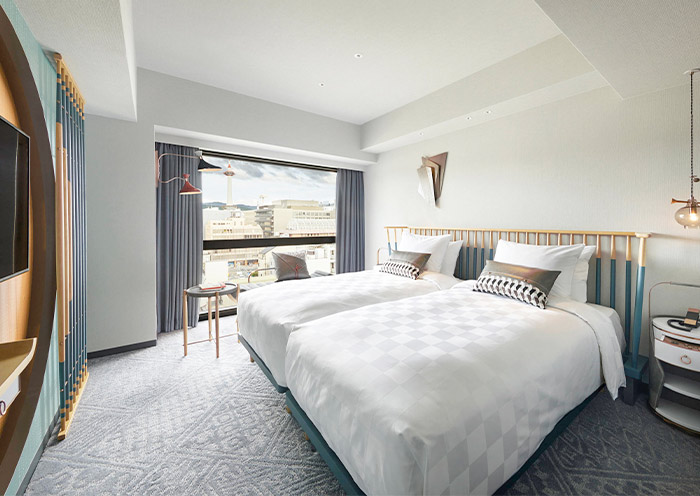


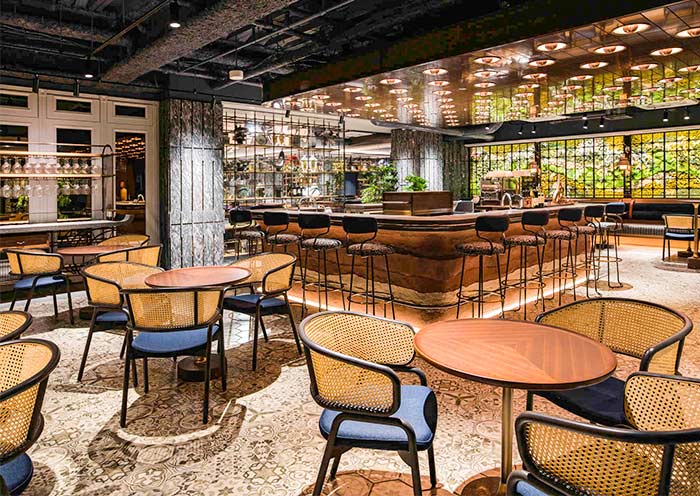
We carefully select accommodations across the five “Stans” to ensure both comfort and authenticity.
In Cities:
You will stay in well-located hotels (3-5 stars, with 4 stars recommended) - a mix of international chains and charming boutique hotels. All are clean, comfortable, non-smoking, and offer easy access to lively bazaars, shopping streets, and major attractions. Free Wi-Fi is available in most properties.
In Villages & Countryside:
Around the Seven Lakes, Pamir, and Issyk-Kul areas, accommodation is mainly in cozy family guesthouses, mountain lodges, or traditional yurt camps. Facilities are simple but authentic, letting you experience the local way of life. Yurt camps in Kyrgyzstan and Kazakhstan are usually shared or semi-private, with communal or partially private bathrooms. Nights can be chilly, but electric blankets or stoves are typically provided.
Camping Experience:
At places like the Darvaza Gas Crater, you will stay in fixed or mobile tents with basic shared facilities. Nights can be windy with significant temperature drops, so warm clothing is recommended.
Photo Gallery for This Itinerary
Latest Central Asia Tours Reviews from Our Customers

David
United States
Date of Experience: Oct 15, 2025
Tour Customized by: Amy
You May be Interested in This Tour: 26 Days Central Asia Tour: In-Depth Journey through the Five Stans

Sofia Rodriguez
Spain
Date of Experience: Sep 25, 2025
Tour Customized by: Anthony
You May be Interested in This Tour: 5 Days Classic Turkmenistan Tour: UNESCO Ancient Wonders & Door to Hell

Marco-Bianchi
Italy
Date of Experience: Sep 03, 2025
Tour Customized by: Alina
You May be Interested in This Tour: 8 Days Uzbekistan Silk Road Tour - Tashkent, Khiva, Bukhara & Samarkand
Price: Request
(Based on a private tour for two people. Price varies depending on program, travel date, number of people.)
Free Enquiry! You don’t need to pay for the reservation.
- United States (+1)
- Australia (+61)
- Singapore (+65)
- Malaysia (+60)
- Philippines (+63)
- Canada (+1)
- Italy (+39)
- Indonesia (+62)
- United Kingdom (+44)
- Spain (+34)
- Mexico (+52)
- Hong Kong (+852)
- Thailand (+66)
- United Arab Emirates (+971)
- New Zealand (+64)
- South Africa (+27)
- Germany (+49)
- Brazil (+55)
- India (+91)
- France (+33)
- Vietnam (+84)
- The Netherlands (+31)
- Saudi Arabia (+966)
- Ireland (+353)
- Argentina (+54)
- Switzerland (+41)
- Romania (+40)
- Pakistan (+92)
- Japan (+81)
- Portugal (+351)
- Bangladesh (+880)
- South Korea (+82)
- Puerto Rico (+1)
- Türkiye (+90)
- China (+86)
- Belgium (+32)
- Qatar (+974)
- Greece (+30)
- Taiwan (+886)
- Austria (+43)
- Poland (+48)
- Israel (+972)
- Chile (+56)
- Sri Lanka (+94)
- Nigeria (+234)
- Peru (+51)
- Colombia (+57)
- Hungary (+36)
- Nepal (+977)
- Denmark (+45)
- Bulgaria (+359)
- Norway (+47)
- Slovenia (+383)
- Sweden (+46)
- Kuwait (+965)
- Costa Rica (+506)
- Ecuador (+593)
- Venezuela (+58)
- Malta (+356)
- Croatia (+385)
- Tunisia (+216)
- Czechia (+420)
- Mongolia (+976)
- Bahrain (+973)
- Mauritius (+230)
- Papua New Guinea (+675)
- Cambodia (+855)
- Dominican Republic (+1)
- Luxembourg (+352)
- Finland (+358)
- Guatemala (+502)
- Myanmar (+95)
- Maldives (+960)
- Slovakia (+421)
- Laos (+856)
- Serbia (+381)
- Brunei (+673)
- Oman (+968)
- Macao (+853)
- Panama (+507)
- Morocco (+212)
- Jordan (+962)
- Georgia (+995)
- Fiji (+679)
- Bolivia (+591)
- Lithuania (+370)
- Bahamas (+1)
- Cyprus (+357)
- Latvia (+371)
- Bhutan (+975)
- Iraq (+964)
- Iran (+98)
- Kenya (+254)
- Jamaica (+1)
- Zimbabwe (+263)
- Azerbaijan (+994)
- Uruguay (+598)
- Estonia (+372)
- Andorra (+376)
- Cameroon (+237)
- Ghana (+233)
- Kazakhstan (+7)
- Nicaragua (+505)
- Egypt (+20)
- Russia (+7)
- Albania (+355)
- Réunion (+262)
- Montenegro (+382)
- Algeria (+213)
- Afghanistan (+93)
- Martinique (+596)
- Uganda (+256)
- Honduras (+504)
- North Macedonia (+389)
- Trinidad and Tobago (+1)
- Suriname (+597)
- Antigua and Barbuda (+1)
- Zambia (+260)
- Ukraine (+380)
- Armenia (+374)
- Barbados (+1)
- Belarus (+375)
- Palestine (+970)
- Lesotho (+266)
- Moldova (+373)
- Ethiopia (+251)
- French Polynesia (+689)
- Gambia (+220)
- Guam (+1)
- Gibraltar (+350)
- Isle of Man (+44)
- New Caledonia (+687)
- El Salvador (+503)
- Comoros (+269)
- Seychelles (+248)
- Chad (+235)
- Samoa (+685)
- Cook Islands (+682)
- Palau (+680)
- Paraguay (+595)
- DR Congo (+243)
- Solomon Islands (+677)
